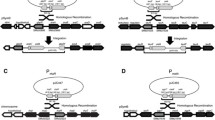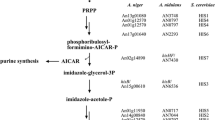Abstract
To study the effects of selection marker, promoter type, and copy number on heterologous expression in Aspergillus nidulans, strains were constructed with single- and multicopy plasmid integrations bearing a reporter gene (lacZ) under the control of either an inducible (alcA) or constitutive (gpdA) promoter and one of three Aspergillus nutritional marker genes (argB, trpC, or niaD). β-Galactosidase activity in the transformants varied over three orders of magnitude, with the majority of levels in the range of 5×103–1×104 U/mg. Significant differences in mean expression levels were found when comparing single-copy transformants with the same promoter but a different marker. Transformants with the argB marker had the highest average expression, ∼threefold over the trpC or niaD clones. For each promoter, maximal expression for the set was seen in the range of the single-copy clones, implying that increasing the copy number does not reliably increase expression in Aspergillus.





Similar content being viewed by others
References
Aramayo R, Adams TH et al (1989) A large cluster of highly expressed genes is dispensable for growth and development in Aspergillus-Nidulans. Genetics 122(1):65–71
Barratt RW, Johnson GB et al (1965) Wild-type and mutant stocks of Aspergillus Nidulans. Genetics 52(1):233–246
Bird D, Bradshaw R (1997) Gene targeting is locus dependent in the filamentous fungus Aspergillus nidulans. Mol Gen Genet 255(2):219–225
Boeckman F, Brisson M et al (2001) Real-time PCR: general considerations. Bulletin 2593. Bio-Rad Laboratories, Hercules
Bradford MM (1976) Rapid and sensitive method for quantitation of microgram quantities of protein utilizing principle of protein-dye binding. Anal Biochem 72(1–2):248–254
Chaveroche M-K, Ghigo J-M et al (2000) A rapid method for efficient gene replacement in the filamentous fungus Aspergillus nidulans. Nucleic Acids Res 28(22):e97
Chiou CH, Miller M et al (2002) Chromosomal location plays a role in regulation of aflatoxin gene expression in Aspergillus parasiticus. Appl Environ Microbiol 68(1):306–315
Chow TYK, Käfer E (1993) A rapid method for isolation of total nucleic acids from Aspergillus nidulans. Fungal Genetics Newsletter 40:25–27
Clutterbuck (2004) MATE transposable elements in Aspergillus nidulans: evidence of repeat-induced point mutation. Fungal Genet Biol 41(3):308–316
Cogoni C (2001) Homology-dependent gene silencing mechanisms in fungi. Annu Rev Microbiol 55:381–406
Davies RW (1991) Molecular biology of a high-level recombinant protein production system in Aspergillus. In: Leong SA, Berka RM (eds) Molceular industrial mycology. Marcel Dekker, New York, pp 45–81
Davis MA, Hynes MJ (1991) Regulatory circuits in Aspergillus nidulans. In: Bennett JW (ed) More gene manipulations in fungi. Academic, New York, pp 151–189
Dawe AL, Willins DA et al (2000) Increased transformation efficiency of Aspergillus nidulans protoplasts in the presence of dithiothreitol. Anal Biochem 283(1):111–112
Ebbole DJ (1990) Vectors for construction of translational fusions to beta-galactosidase. Fungal Genetics Newsletter 37:15–16
Felenbok B (1991) The ethanol utilization regulon of Aspergillus-Nidulans — the Alca–Alcr system as a tool for the expression of recombinant proteins. J Biotechnol 17(1):11–17
Gouka RJ, Gerk C et al (1999) Transformation of Aspergillus awamori by Agrobacterium tumefaciens-mediated homologous recombination. Nat Biotechnol 17(6):598–601
Hamer JE, Timberlake WE (1987) Functional-organization of the Aspergillus-Nidulans Trpc promoter. Mol Cell Biol 7(7):2352–2359
Hammond TM, Keller NP (2005) RNA silencing in Aspergillus nidulans independent of RNA-dependent RNA polymerases. Genetics 169(2):607–617
Hynes MJ (1996) Genetic transformation of filamentous fungi. J Genet 75(3):297–311
Ichioka D, Itoh T et al (2001) An Aspergillus nidulans uvsC null mutant is deficient in homologous DNA integration. Mol Gen Genet 264(5):709–715
Johnstone IL (1985) Transformation of Aspergillus-Nidulans. Microbiol Sci 2(10):307–311
Johnstone IL, McCabe PC et al (1990) Isolation and characterization of the Crna–Niia–Niad Gene-Cluster for nitrate assimilation in Aspergillus-Nidulans. Gene 90(2):181–192
Kelly JM, Hynes MJ (1987) Multiple copies of the amdS gene of Aspergillus nidulans cause titration of trans-acting regulatory proteins. Curr Genet 12(1):21–31
Lee KW, Ebbole DJ (1996) A reliable microplate assay for determination of B-galactosidase activity in Neurospora crassa strains bearing lacZ fusions. Fungal Genetics Newsletter 43:35–36
Maine EM (2000) A conserved mechanism for post-transcriptional gene silencing? Genome Biol 1(3): reviews 1018.1–reviews 1018.4
May G (1992) Fungal technology. In: Kinghorn JR, Turner G (eds) Applied molecular genetics of filamentous fungi. Chapman & Hall, London
Michielse CB, Arentshorst M et al (2005) Agrobacterium-mediated transformation leads to improved gene replacement efficiency in Aspergillus awamori. Fungal Genet Biol 42(1):9–19
Miller JH (1972) Experiments in molecular genetics. Cold Spring Harbor Laboratory Press, Cold Spring Harbor
Miller BL, Miller KY et al (1987) Position-dependent and position-independent mechanisms regulate cell-specific expression of the spoc1 gene-cluster of Aspergillus-Nidulans. Mol Cell Biol 7(1):427–434
Punt PJ, Dingemanse MA et al (1990) Functional elements in the promoter region of the Aspergillus-Nidulans Gpda gene encoding Glyceraldehyde-3-Phosphate Dehydrogenase. Gene 93(1):101–109
Sambrook J, Russell DW (2001) Molecular cloning: a laboratory manual. Cold Spring Harbor Laboratory Press, Cold Spring Harbor
Schmidt FR (2004) RNA interference detected 20 years ago? Nat Biotechnol 22(3):267–268
Som T, Kolaparthi VSR (1994) Developmental decisions in Aspergillus-Nidulans are modulated by ras activity. Mol Cell Biol 14(8):5333–5348
Upshall A, Gilbert T et al (1986) Molecular analysis of the argb gene of Aspergillus-Nidulans. Mol Gen Genet 204(2):349–354
van den Hondel C, Punt P et al (1991) Heterologous gene expression in filamentous fungi. In: Bennett JW (ed) More gene manipulations in fungi. Academic, New York, pp 396–428
Verdoes JC, Punt PJ et al (1995) Molecular-genetic strain improvement for the overproduction of fungal proteins by filamentous fungi. Appl Microbiol Biotechnol 43(2):195–205
Yelton MM, Hamer JE et al (1983) Developmental regulation of the Aspergillus-Nidulans-Trpc gene. Proc Natl Acad Sci USA 80(24):7576–7580
Acknowledgement
This research was funded by a grant from Merck.
Author information
Authors and Affiliations
Corresponding author
Rights and permissions
About this article
Cite this article
Lubertozzi, D., Keasling, J.D. Marker and promoter effects on heterologous expression in Aspergillus nidulans . Appl Microbiol Biotechnol 72, 1014–1023 (2006). https://doi.org/10.1007/s00253-006-0368-8
Received:
Revised:
Accepted:
Published:
Issue Date:
DOI: https://doi.org/10.1007/s00253-006-0368-8




